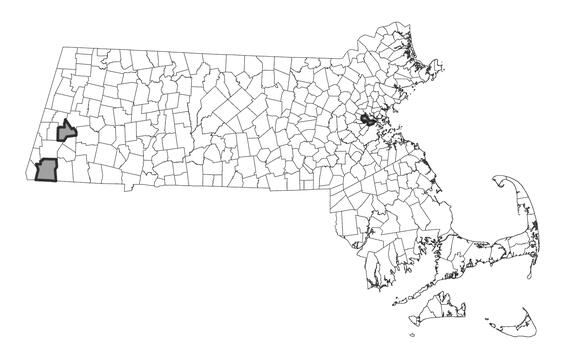- Scientific name: Gentiana andrewsii
- Species of Greatest Conservation Need (MA State Wildlife Action Plan)
- Endangered (MA Endangered Species Act)
Description
Andrews’ bottle gentian is a showy perennial gentian (family gentianaceae) of moist meadows and thickets, with vibrant blue-violet flowers that bloom late summer to early autumn. Several to many unbranched flowering stems arise from a stout persistent base and long tap root, reaching a height of 3-8 dm (1-2.6 ft). Stems are smooth, round, and light green or purple. The leaves are opposite, entire, and lustrous green, 3-15 cm (1.2-6 in) long and 2-4 cm (0.8-1.5 in) wide. They are oblong egg-shaped, sessile to the base, and pointed at the tip. The lowest leaves are often reduced to small, fused bracts, while the middle and upper leaves gradually get larger. The uppermost tier form a whorl of four to six leaves at the base of the flower cluster. The terminal flower cluster may have two to ten flowers; flowers are also present in the upper leaf axils. The five-lobed blue-violet (sometimes white) flowers are 3-4.5 cm (1.2-1.8 in) long and stalkless; they are closed, bottle-shaped, and look like inflated oversized flower buds with a short protruding fringe at the apex. The margins of the calyx lobes are slightly hairy. The elliptic fruit capsule is dry and two-valved, and contains many oblong, lustrous, whitish-brown seeds. The seeds are broadly winged and easily transported by wind and water. This species was named for Henry C. Andrews, an accomplished botanical artist and engraver whose work was published in the early 1800s in England.
Upon close examination of the flower, one will note there are folds, or pleats along the seams of the fused corolla lobes. The pleats may act as expansion joints to allow access for bees and other insects into the flower. The pleats between the corolla lobes are fimbriate at the top, with tiny teeth, exceeding the corolla lobes by 1-2 mm (0.04-0.08 in). The edges of the pleats form a distinct fringe at the top of the closed flower.
Closed gentian (gentiana clausa) is very similar to and can co-occur with Andrews’ bottle gentian. However, in closed gentian, the pleats between the corolla lobes have a few small, rounded lobes instead of tiny teeth. The apex appears closed at the top, with rounded corolla lobes and no fringe.
Life cycle and behavior
This is a perennial species.
Population status
Andrews’ bottle gentian is listed under the Massachusetts Endangered Species Act (MESA) as endangered. All listed species are legally protected from killing, collection, possession, or sale, and from activities that would destroy habitat and thus directly or indirectly cause mortality or disrupt critical behaviors. The MassWildlife’s Natural Heritage & Endangered Species Program has 13 records from 6 counties: Berkshire, Essex, Middlesex, Norfolk, Suffolk, and Worcester. Four of these records have been observed within the last 25 years.
Distribution and abundance
Georgia to Arkansas, north to Massachusetts, Vermont, southwestern Quebec, Southern Ontario, Manitoba, and Saskatchewan.

Distribution in Massachusetts. 2000-2025. Based on records in the Natural Heritage Database.
Habitat
Andrews’ bottle gentian inhabits moist meadows and shrub thickets bordering streams, rivers, and isolated wetlands. Current occurrences in Massachusetts are on limestone soils. Occasional flooding and water level fluctuations may ensure the open character of these early successional habitats. Associated species include small-flowered agrimony (Agrimonia parviflora; Endangered), rough goldenrod (Solidago rugosa), grass-leaf goldenrod (Euthamia graminifolia), lurid sedge (Carex lurida), Yellow fox sedge (C. annectans), blue flag (Iris versicolor), swamp milkweed (Asclepias incarnata), speckled alder (Alnus rugosa), and silky dogwood (Swida amomum).
Healthy habitats are vital for supporting native wildlife and plants. Explore habitats and learn about conservation and restoration in Massachusetts.
Threats
Changes in ground water and surface water hydrology, as well as sedimentation and erosion patterns, may influence soil moisture and nutrient levels, and cause shifts in plant community structure and composition. Tall forbs, shrubs, and small trees may increase at sites due to a lack of small-scale disturbances that maintain early successional habitats. Andrews’ bottle gentian habitat is susceptible to exotic plant invasions and competition from species such as Purple Loosestrife (Lythrum salicaria), Japanese Barberry (Berberis thunbergii), Multiflora Rose (Rosa multiflora), and Cypress Spurge (Euphorbia cyparissias).
Conservation
Andrews’ bottle gentian occurrences should be monitored to better understand population dynamics and threats at each site.The natural hydrologic regime should be preserved to ensure sustained open, high-quality habitat. Andrews’ bottle gentian habitat should also be monitored for competition and over-shading by aggressive native and exotic invasive plants. Populations may benefit from well-timed (i.e., outside growing, flowering, and fruiting periods) vegetation management activities such as cutting, mowing, and burning of early successional vegetation to reduce shrub encroachment and provide a mineral seed bed for germination. Continue to inventory, monitor, and control invasive species; if exotic plants are invading habitat, a plan for control should be constructed. All active management within the habitat of a rare plant population (including invasive species removal) is subject to review under MESA and should be planned in close consultation with MassWildlife’s Natural Heritage & Endangered Species Program.
Contact
| Date published: | April 29, 2025 |
|---|